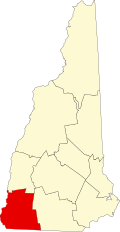Foothill Farm | |
 | |
| Location | Old Troy Rd., Dublin, New Hampshire |
|---|---|
| Coordinates | 42°53′47″N72°6′16″W / 42.89639°N 72.10444°W |
| Area | 1 acre (0.40 ha) |
| Built | 1914 |
| Architect | Lavalle, John |
| Architectural style | Colonial Revival |
| MPS | Dublin MRA |
| NRHP reference No. | 83004025 [1] |
| Added to NRHP | December 15, 1983 |
Foothill Farm is a historic farmhouse on Old Troy Road in Dublin, New Hampshire, United States. Built about 1914 as part of the large Amory summer estate, it is a distinctive local example of Dutch Colonial Revival architecture. [2] The house was listed on the National Register of Historic Places in 1983. [1]


